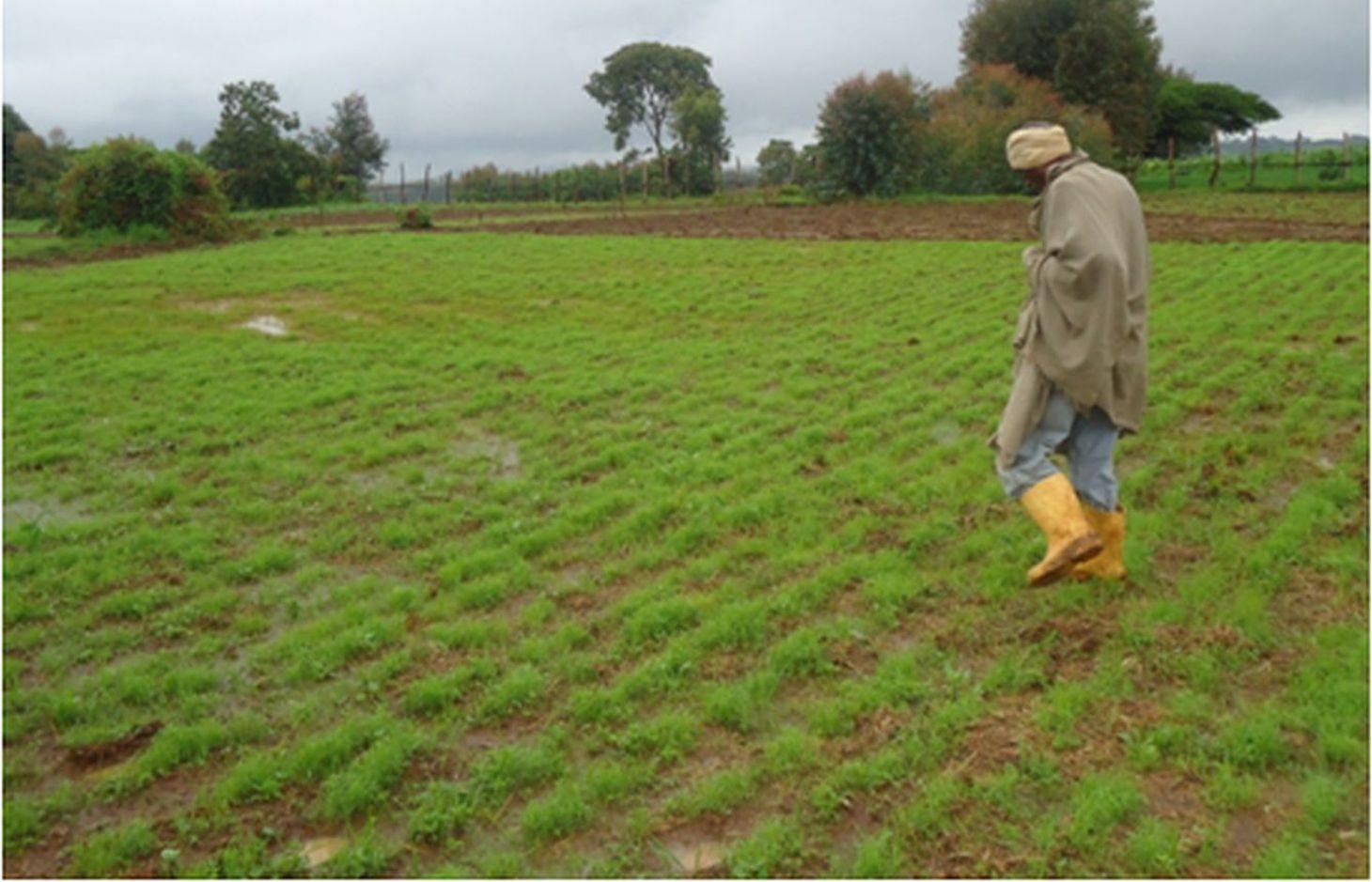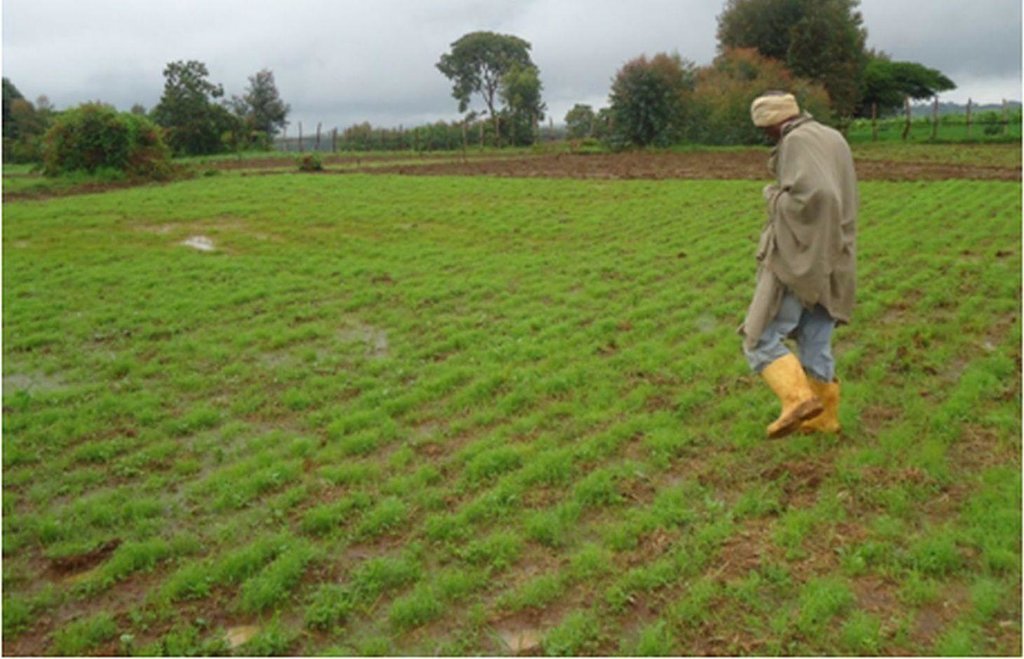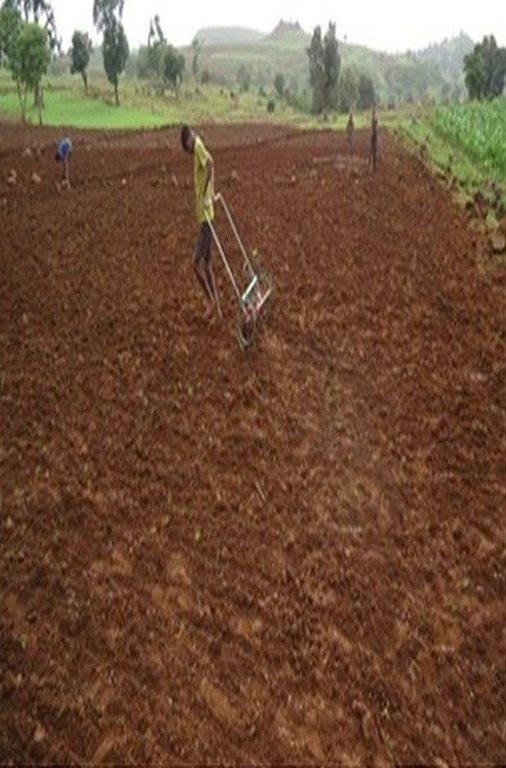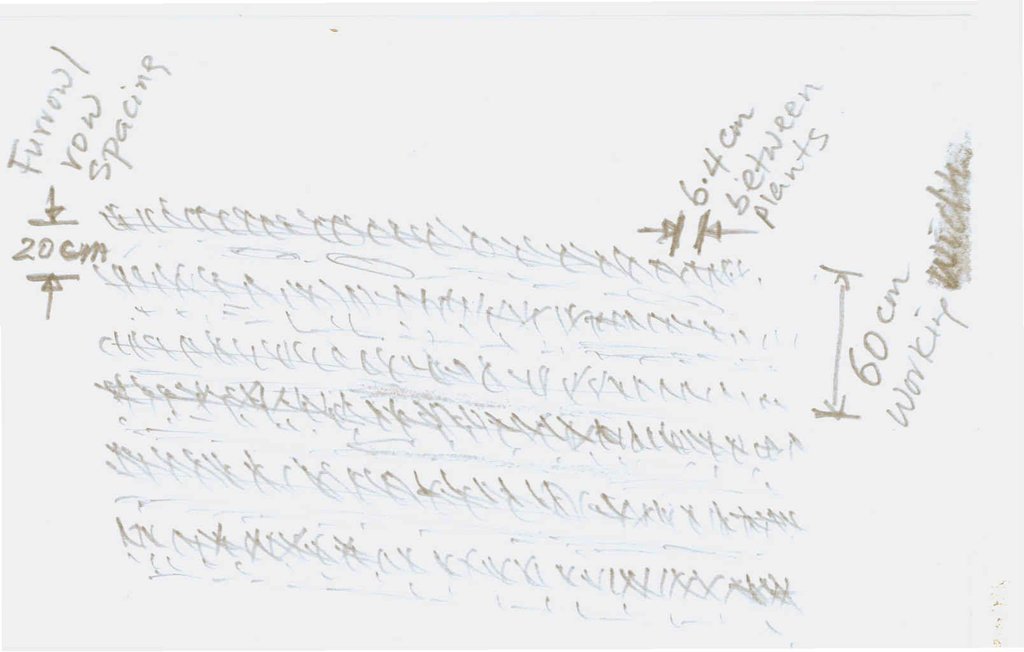Teff row planting [埃塞俄比亚]
- 创建:
- 更新:
- 编制者: Gizaw Desta Gessesse
- 编辑者: –
- 审查者: Alexandra Gavilano
Teff bemesmr mezrat (Amharic)
technologies_1192 - 埃塞俄比亚
查看章节
全部展开 全部收起1. 一般信息
1.2 参与该技术评估和文件编制的资源人员和机构的联系方式
SLM专业人员:
Tefferra Abu
Bahir Dar Agricultural Mechanization and Food Science Research Centre
埃塞俄比亚
有助于对技术进行记录/评估的机构名称(如相关)
Water and Land Resource Centre (WLRC) - 埃塞俄比亚1.3 关于使用通过WOCAT记录的数据的条件
编制者和关键资源人员接受有关使用通过WOCAT记录数据的条件。:
是
2. SLM技术的说明
2.1 技术简介
技术定义:
Teff row planting is an agronomic practice used to place Teff seeds (very small size) in rows of about 20cm apart and at predetermined depth with sufficient cover of firm soil.
2.2 技术的详细说明
说明:
Teff is a staple crop in Ethiopia and used to make 'Injera'. Teff is commonly planted in broadcast technique with a seed rate of 25-30 kg per hectare. This practice results in high competition for nutrient and water, lodging and low productivity (on average 1 ton/ha). Teff row planting is a newly adopted planting method applied for small size seeds of Teff grain. The row planting technique reduces the seed rate from 25kg/ha to 5-8 kg per hectare, ease the weed management, reduce lodging problem, and lessen plant density and then competition for sunlight, nutrient and water. It is practiced on Teff growing soils except on heavy clay soils or Vertisols where it is difficult to prepare defined rows due to the extreme swelling nature of the soil under near saturation moisture condition. However, under optimum soil moisture (45-50%) it is possible to place seeds in row using manual seed drill in black soils with clay texture. The technique is not perfectly working on stony fields. Seed application is possible using locally available plastic bottles with needle size opening to drop seeds, and newly manufactured seed drill pulled by one person.
Purpose of the Technology: The main purpose to practice Teff row planting is to reduce plant density or population per unit area and thereby increase productivity. It also aim to reduce the lodging problem. Additional advantage of row planting for small grain crop, there is some extent of labor reduction for weeding to some extent.
Establishment / maintenance activities and inputs: Teff row planting technique applies on fine seed bed after 3-5 tillage frequency using local ard plough called maresha pulled by pair of oxen. Once the seed bed is finely prepared, first using local adopted application tools like plastic bottles or hand metering the farmer prepares seed rate of 5-8 kg per hectare mixed with proportional sand (approximately seed to sand ratio of 1:3) - it is difficult to manage uniform application and even distribution by applying the seed alone. He applies along the row and step on to cover the seed and compact it. Similarly, fertilizer is applied in the same way. Second option, after the preparation of fine seed bed, seed application is facilitated using drum type manual seed drill (of weight 21 kg) manufactured by Bahir Dar Agricultural Mechanization and Food Science Research Center (BAMFSRC) having 3 rows of 20cm apart, average depth and width of planting furrow equals to 3.6 cm and 6.4 cm and operating at field capacity of 0.06ha/hr. The drill can apply 3-6 kg/ha seed rate and pulled by one person. At tillering stage urea is top dressed. The technique requires 50-60 person days per hectare to apply seed and fertilizer using hand metering/bottles compared to 2-4 person days per hectare using drum type seed drill. Labor requirement for weeding is also reduced by using row planting than broadcast method.
Natural / human environment: Teff grows on wider environment of altitude range 1800-2600 m above sea level. It performs well with annual rainfall of 750-850 mm and temperature of 10-27 degree Celsius. In fact, there are varieties with short growing period adapted under low rainfall conditions. The row planting technique applies commonly on red clay soils having high water holding capacity. The technique potentially applies on slopes ranging from 0-10% with low stone cover.
Teff row planting using manual seed application or hand metering technique can easily be practiced by households having large family labor. Farm households who used the manual seed drill of drum type should have the capacity to afford the seed drill and able to buy fertilizer. Teff is produced for food and market. It has a good price for sale.
Although teff has high market price in country as well as an emerging export market potential, it is produced annually by subsistence farmers. The land holding is small to meet their family food demands. Their wealth condition ranges poor to average characterized with low agricultural advisory, market and water supply services and inadequate infrastructures. Energy supply is relied on biomass energy. Rural education and health services are improved. Rural unemployment and landless populations are at high rates. In general, the well being of the rural people is under poor condition.
2.3 技术照片
关于照片的一般说明:
The area covered with Teff row planting referred in this database only considers the area of the pre-scale up activities in the WLRC learning watersheds. The practice is steadily growing over years in teff growing areas of the country in general and Amhara region in particular.
2.5 已应用该技术的、本评估所涵盖的国家/地区/地点
国家:
埃塞俄比亚
区域/州/省:
Amhara
有关地点的进一步说明:
Bahir Dar Zuria, Mecha, Yilmana Densa, and Dembecha
具体说明该技术的分布:
- 均匀地分布在一个区域
如果不知道精确的区域,请注明大致覆盖的区域:
- 0.1-1 平方千米
注释:
Boundary points of the Technology area: 10.630850, 37.506877; 11.274962, 37.226641; 11.355705, 37.426134; 11.649907, 37.500604
2.6 实施日期
如果不知道确切的年份,请说明大概的日期:
- 不到10年前(最近)
2.7 技术介绍
详细说明该技术是如何引入的:
- 在实验/研究期间
注释(项目类型等):
Teff row planting technique was started in research stations 10 to20 years ago. The technique is extended to large number of farmers' field since 2011 through the scale up program of the Ministry of Agriculture. For instance, in 2013 the Amhara region planned to cover 20-30% of teff growing fields.
3. SLM技术的分类
3.2 应用该技术的当前土地利用类型

农田
- 一年一作
- teff
每年的生长季节数:
- 1
具体说明:
Longest growing period in days: 180Longest growing period from month to month: July to December

牧场
- Livestock is grazing on crop residues
注释:
Major land use problems (compiler’s opinion): Major land use problems are soil erosion by water, soil nutrient depletion, gully erosion, steep slope cultivation, land fragmentation, and inappropriate runoff drainage practices like drainage ditches on cultivated fields.
Major land use problems (land users’ perception): Land users commonly specify soil erosion by water, shallow soil depth or soil depletion, low productivity of the soil, scarcity of water, and shortage of grazing land or pasture.
3.4 供水
该技术所应用土地的供水:
- 混合雨水灌溉
3.6 包含该技术的可持续土地管理措施

农艺措施
- A1:植被和土壤覆盖层
注释:
Type of agronomic measures: mineral (inorganic) fertilizers
3.7 该技术强调的主要土地退化类型

物理性土壤退化
- Pc:压实
- Pk:熟化和结壳
注释:
Main causes of degradation: soil management (Teff fields are tilled 4-5 times and heavily trampled/compacted by livestock before sowing)
Secondary causes of degradation: Heavy / extreme rainfall (intensity/amounts) (Heavy rainfall cause high runoff and then erosion. It also create sealing effect on the soil surface)
3.8 防止、减少或恢复土地退化
具体数量名该技术与土地退化有关的目标:
- 防止土地退化
- 减少土地退化
4. 技术规范、实施活动、投入和成本
4.1 该技术的技术图纸
技术规范(与技术图纸相关):
A sketch describing Teff row planting
Location: Aba Gerima, Debre Mewi, Debre Yacob, Gosh Learning. West Gojam/ Amhara Region
Technical knowledge required for field staff / advisors: high (Because of its small seed size, the method requires knowledge of the soil where it performs well and at what depth the seed is placed so that there is high germination and minimizing lodging problem)
Technical knowledge required for land users: high (The land user has to develop capacity and skills on the specific soil and slope conditions where row planting performs well, spacing of rows, depth of furrow and seed quantity per unit area.)
Main technical functions: improvement of surface structure (crusting, sealing), increase of biomass (quantity), Reduction of plant population and competition effect
Secondary technical functions: improvement of topsoil structure (compaction)
Agronomic measure: Row planting
Material/ species: Teff seeds
Quantity/ density: 3-6kg/ha
Remarks: Spacing between rows is 20cm
Mineral (inorganic) fertilizers
Material/ species: Urea and DAP
Quantity/ density: 100 kg/ha
Remarks: for each type of fertilizer
作者:
Gizaw Desta, WLRC
日期:
2014-8-15
4.2 有关投入和成本计算的一般信息
其它/国家货币(具体说明):
ETH BIRR
如相关,注明美元与当地货币的汇率(例如1美元=79.9巴西雷亚尔):1美元=:
20.0
注明雇用劳工的每日平均工资成本:
3.00
4.3 技术建立活动
| 活动 | 时间(季度) | |
|---|---|---|
| 1. | Drum type row teff seeder (with 3 rows) |
4.4 技术建立所需要的费用和投入
| 对投入进行具体说明 | 单位 | 数量 | 单位成本 | 每项投入的总成本 | 土地使用者承担的成本% | |
|---|---|---|---|---|---|---|
| 设备 | machine use | pc | 1.0 | 71.0 | 71.0 | 100.0 |
| 技术建立所需总成本 | 71.0 | |||||
| 技术建立总成本,美元 | 3.55 | |||||
4.5 维护/经常性活动
| 活动 | 时间/频率 | |
|---|---|---|
| 1. | Tillage | Annually after onset of rain, 4-5 times |
| 2. | Seeding | After the soil gets sufficient moisture annually |
| 3. | Weeding | 2-3 times per season |
| 4. | Harvesting | Annually at maturity period (Nov-Dec) |
| 5. | Threshing | Annually during slack period (Dce-Jan) |
| 6. | Transporting and storing grain and straw | Annually during slack period |
4.6 维护/经常性活动所需要的费用和投入(每年)
| 对投入进行具体说明 | 单位 | 数量 | 单位成本 | 每项投入的总成本 | 土地使用者承担的成本% | |
|---|---|---|---|---|---|---|
| 劳动力 | labour | 1.0 | 318.0 | 318.0 | 100.0 | |
| 设备 | animal traction | 1.0 | 266.0 | 266.0 | 100.0 | |
| 植物材料 | seeds | 1.0 | 4.5 | 4.5 | 100.0 | |
| 植物材料 | fertilizer | 1.0 | 150.0 | 150.0 | 100.0 | |
| 技术维护所需总成本 | 738.5 | |||||
| 技术维护总成本,美元 | 36.92 | |||||
注释:
Machinery/ tools: Seed drill, local plough, sickle, hoe
The costs are calculated on hectare basis covered by row planting method. The costs apply for February/March 2014
4.7 影响成本的最重要因素
描述影响成本的最决定性因素:
The implementation costs are subject to change due to fluctuation in seasonal labor demand, price of fertilizer, price of iron to construct seed drill, and inflation
5. 自然和人文环境
5.1 气候
年降雨量
- < 250毫米
- 251-500毫米
- 501-750毫米
- 751-1,000毫米
- 1,001-1,500毫米
- 1,501-2,000毫米
- 2,001-3,000毫米
- 3,001-4,000毫米
- > 4,000毫米
农业气候带
- 半湿润
- 半干旱
Thermal climate class: subtropics
5.2 地形
平均坡度:
- 水平(0-2%)
- 缓降(3-5%)
- 平缓(6-10%)
- 滚坡(11-15%)
- 崎岖(16-30%)
- 陡峭(31-60%)
- 非常陡峭(>60%)
地形:
- 高原/平原
- 山脊
- 山坡
- 山地斜坡
- 麓坡
- 谷底
垂直分布带:
- 0-100 m a.s.l.
- 101-500 m a.s.l.
- 501-1,000 m a.s.l.
- 1,001-1,500 m a.s.l.
- 1,501-2,000 m a.s.l.
- 2,001-2,500 m a.s.l.
- 2,501-3,000 m a.s.l.
- 3,001-4,000 m a.s.l.
- > 4,000 m a.s.l.
5.3 土壤
平均土层深度:
- 非常浅(0-20厘米)
- 浅(21-50厘米)
- 中等深度(51-80厘米)
- 深(81-120厘米)
- 非常深(> 120厘米)
土壤质地(表土):
- 中粒(壤土、粉土)
- 细粒/重质(粘土)
表土有机质:
- 高(>3%)
- 中(1-3%)
5.4 水资源可用性和质量
地下水位表:
> 50米
地表水的可用性:
好
水质(未处理):
仅供农业使用(灌溉)
5.5 生物多样性
物种多样性:
- 低
5.6 应用该技术的土地使用者的特征
生产系统的市场定位:
- 生计(自给)
- 混合(生计/商业)
非农收入:
- 低于全部收入的10%
相对财富水平:
- 贫瘠
- 平均水平
个人或集体:
- 个人/家庭
机械化水平:
- 手工作业
- 畜力牵引
性别:
- 女人
- 男人
说明土地使用者的其他有关特征:
Difference in the involvement of women and men: Women play a role of applying seeds either using locally made plastic bottles or using the manual drum type seed drill to pull. However, men are involved in both in tillage and seeding practices.
Population density: 100-200 persons/km2
Annual population growth: 2% - 3%
5.7 应用该技术的土地使用者使用的平均土地面积
- < 0.5 公顷
- 0.5-1 公顷
- 1-2 公顷
- 2-5公顷
- 5-15公顷
- 15-50公顷
- 50-100公顷
- 100-500公顷
- 500-1,000公顷
- 1,000-10,000公顷
- > 10,000公顷
这被认为是小规模、中规模还是大规模的(参照当地实际情况)?:
- 小规模的
注释:
Average area of land owned or leased by land users applying the Technology: < 0.5 ha, 0.5-1 ha, 1-2 ha
5.8 土地所有权、土地使用权和水使用权
土地所有权:
- 州
- 个人,有命名
用水权:
- 自由进入(无组织)
5.9 进入服务和基础设施的通道
健康:
- 贫瘠
- 适度的
- 好
教育:
- 贫瘠
- 适度的
- 好
技术援助:
- 贫瘠
- 适度的
- 好
就业(例如非农):
- 贫瘠
- 适度的
- 好
市场:
- 贫瘠
- 适度的
- 好
能源:
- 贫瘠
- 适度的
- 好
道路和交通:
- 贫瘠
- 适度的
- 好
饮用水和卫生设施:
- 贫瘠
- 适度的
- 好
金融服务:
- 贫瘠
- 适度的
- 好
6. 影响和结论性说明
6.1 该技术的现场影响
社会经济效应
生产
作物生产
SLM之前的数量:
1.2 ton/ha
SLM之后的数量:
>2.7 ton/ha
饲料生产
SLM之前的数量:
2.4 ton/ha
SLM之后的数量:
5 ton/ha
饲料质量
畜牧生产
收入和成本
农业收入
社会文化影响
食品安全/自给自足
Improved teff agronomic knowledge
生态影响
水循环/径流
地表径流
土壤
土壤水分
土壤结壳/密封
土壤压实
生物多样性:植被、动物
害虫/疾病控制
6.3 技术对渐变气候以及与气候相关的极端情况/灾害的暴露和敏感性(土地使用者认为的极端情况/灾害)
气候有关的极端情况(灾害)
气象灾害
| 该技术是如何应对的? | |
|---|---|
| 局地暴雨 | 不好 |
气候灾害
| 该技术是如何应对的? | |
|---|---|
| 干旱 | 不好 |
其他气候相关的后果
其他气候相关的后果
| 该技术是如何应对的? | |
|---|---|
| 缩短生长期 | 不好 |
6.4 成本效益分析
技术收益与技术建立成本相比如何(从土地使用者的角度看)?
短期回报:
积极
长期回报:
非常积极
技术收益与技术维护成本/经常性成本相比如何(从土地使用者的角度看)?
短期回报:
稍微积极
长期回报:
积极
注释:
Since the new technology (Teff row planting) requires high human labor while placing seeds using hand metering or plastic bottles (locally adopted) to apply the seeds, the land users perceived that the cost of labor is high and can not be affordable using family labor alone. Until they developed experience the return may be considered as slightly positive. However, if the land users adopt to use the manual drum type seed drill the return is very positive and positive as compared to the establishment and recurrent costs, respectively.
6.5 技术采用
注释:
There is a moderate trend towards spontaneous adoption of the Technology
Comments on adoption trend: The adoption is growing with extensive technical guidance and push from the research and extension services.
6.7 该技术的优点/长处/机会
| 土地使用者眼中的长处/优势/机会 |
|---|
|
There is yield advantage both grain and straw How can they be sustained / enhanced? The technique needs an improved tool to reduce labor demand. It has to be supported with improved varieties and agronomic practices |
| It requires small amount of seed |
| According to some farmers it avoids the usual practice called trampling of seed bed by livestock after sowing the seed |
| 编制者或其他关键资源人员认为的长处/优势/机会 |
|---|
|
Teff row planting can bring 30-50% yield advantage compared to the broadcasting method of planting How can they be sustained / enhanced? The yield advantage can be sustained by using an integrated or package of Teff production technologies such as improved teff varieties, recommended fertilizer, pesticides and weeding |
|
It reduces three to four times the amount of seed required using the broadcasting method How can they be sustained / enhanced? This advantage can be enhanced or continue to sustain by using an improved low cost seed drills |
|
The technology eases the weeding practice without damaging the plants How can they be sustained / enhanced? Appropriate low cost weeders or herbicides can be used to further enhance the technique |
|
The technology reduces damage due to lodging problem along with the use of selected Teff varieties having strong stem How can they be sustained / enhanced? This can be sustained if supported with further research in the depth of seed placement and genetic improvement |
6.8 技术的弱点/缺点/风险及其克服方法
| 土地使用者认为的弱点/缺点/风险 | 如何克服它们? |
|---|---|
| The implement has relatively low stability to make straight rows. | Improving the workmanship will solve the problem |
| Non uniform seed application if pulling speed not constant | Proper seed bed preparation and removal of stones will solve the problem |
| 编制者或其他关键资源人员认为的弱点/缺点/风险 | 如何克服它们? |
|---|---|
| Uniform application and distribution of small amount of seed (as low as 5kg) in rows of 20cm apart become challenging compared to the broadcasting technique | This can be overcome by continuous skill development through practice and training |
| The small number of plant populations or vigorous growth of teff plants favor the shoot fly damage. | Application of chemicals will control shootfly |
7. 参考和链接
7.1 信息的方法/来源
7.2 参考可用出版物
标题、作者、年份、ISBN:
(Unpublished Report, 2013): Technical Evaluation and Selection of Suitable Teff Seed Drill in Amhara Region, by team of Researchers in ARARI, Bahir Dar Mechanization and Food Science research Center and Lecturers from Bahir Dar University
标题、作者、年份、ISBN:
Dereje Gorfu and Eshetu Ahmed (unpublished). Crops and Agro-ecological Zones of Ethiopia. Ethiopian Institute of Agricultural Research
标题、作者、年份、ISBN:
http://www.worldbank.org/html/cgiar/newsletter/Sept97/10tef.html
链接和模块
全部展开 全部收起链接
无链接
模块
无模块





